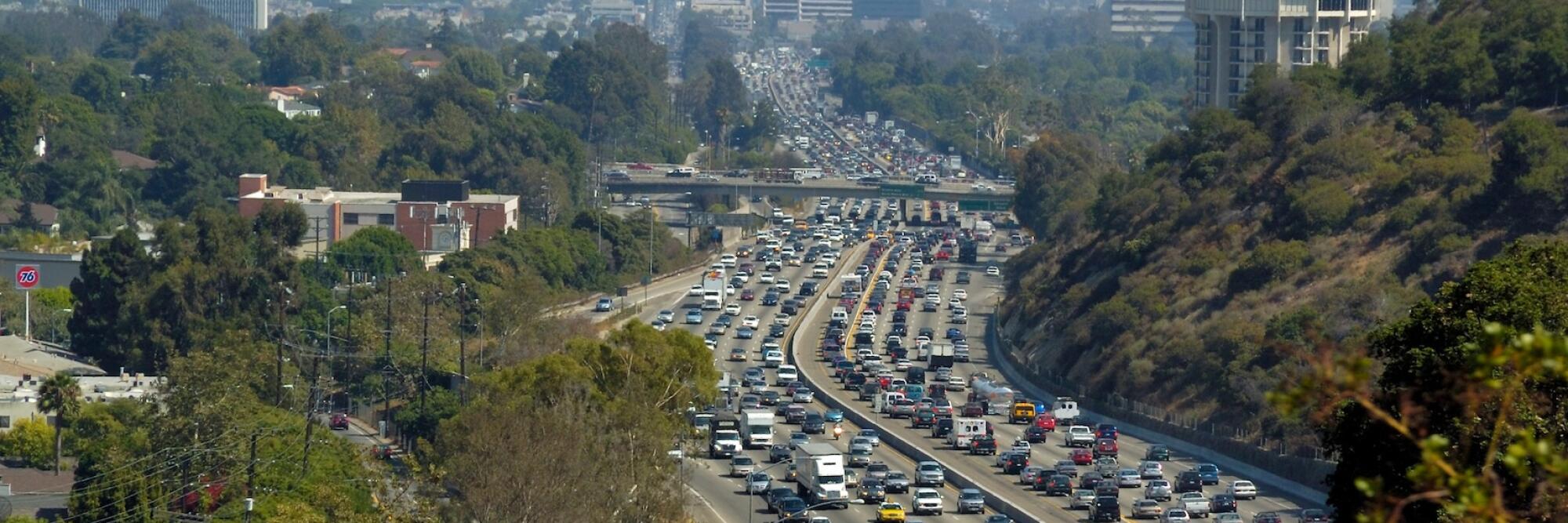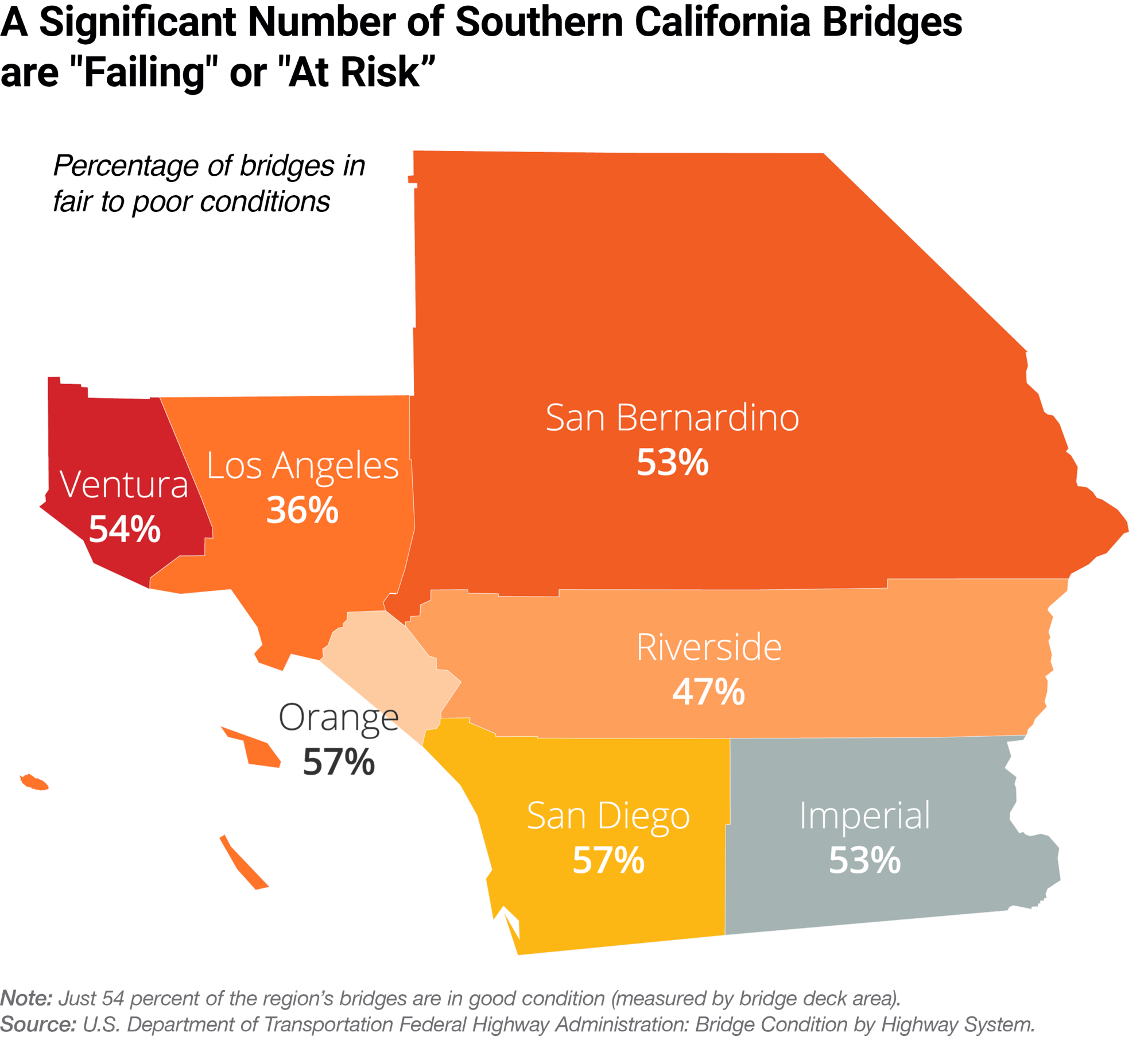
On Saturday, Nov. 11, a massive arson fire erupted underneath the 10 freeway in downtown Los Angeles. In the immediate aftermath, once it was determined that there was no injury or loss of life, the focus shifted instead to how disruptive and destructive the subsequent highway closure would be to the city’s already delicate transportation infrastructure – the fire seemed like it may create a traffic nightmare for weeks or months.
With incredible focus, multi-agency dedication, and a stroke of excellent fortune, the closure was minimized, and any long-term effect on the city’s mobility was generally unaffected. This freak, man-made incident did, however, bring into focus an underlying danger to Southern California that goes beyond an act of man or God – how critical underinvestment in the state’s infrastructure could lead to a far worse outcome today, tomorrow or anytime going forward.
But this dire lack of infrastructure spending is not isolated to any one road, bridge or rail line. The state of these systems and the potential impact of their failure is highlighted and detailed in a new 2024 report – as a new year dawns in Southern California, the data paints a clear picture of what a lack of spending could bring in the short and long term.
The Critical Dangers of Infrastructure Underinvestment
Southern California’s infrastructure influences the economy, health and safety, and residents’ overall quality of life. But the hard facts of age and changing conditions, some due to more extreme weather due to climate change, are taxing California’s roads, canals, bridges, ports, power infrastructure, and more.
The impacts of these underinvestments could be minor inconveniences, like a pothole, or enormous, like a collapsed freeway overpass, or worse. Coupled with the region’s susceptibility to fires, floods, or damaging earthquakes, a critical infrastructure collapse could create loss of life or lasting hardships for entire communities.
Worse yet, these potential infrastructure failures would invariably affect already underserved communities, creating additional hardship for those in the state who are already marginalized.
By the Numbers
While aging infrastructure is a nationwide issue, the scale of problems within California infrastructure, and particularly in Southern California, is staggering. This is partly because of the sheer amount of systems that can be affected – California is the nation’s most populous state and the third-largest. But every two-lane desert highway and downtown interchange have something in common – they’re older, heavily used, and often underinvested in.
The hard numbers underscore these issues:
- Infrastructure Investment has declined 37%: In the last decade, infrastructure investment in Southern California alone has decreased by more than a third. This has impacted the region’s ability to address critical infrastructure needs.
- Southern California ranks 22nd nationally in infrastructure investment: In comparison to other states, if Southern California were its own state, it would sit at 22nd in infrastructure investment and, incredibly, dead last in highway investments.
- Commutes are 20-30% longer: Since 1990, commute times have surged. The increase is especially stark for those in historically marginalized communities, with a 32% increase for Indigenous commuters and a 21% surge for Black commuters, as both cohorts are adversely affected by infrastructure underinvestment.
- Half of SoCal bridges are at-risk: Only 50% of the region’s bridges maintain a status of “good condition,” – signaling a concerning decline in bridge infrastructure.
 (Courtesy of Rebuild SoCal Partnership)
(Courtesy of Rebuild SoCal Partnership) - Water losses are adding up: Over half of our regional water systems are not meeting state standards for limiting water leakage, wasting over 84 million gallons of water per day in a part of the state where the liquid is a precious resource.
- Spending on water infrastructure has been reduced by 38%: Despite these mounting losses, since 2010, a staggering 38% decrease in spending on drinking water infrastructure has affected over a third of water systems in Southern California.
- 85,000 residents fall under a “failing” infrastructure classification, and 25% of systems, affecting 1.3 million residents are classified as “at-risk” or “potentially at-risk”: These infrastructure failures also do or have the potential to affect BIPOC and historically underserved communities adversely.
- Critical port infrastructure will cost $5.7 billion: Future infrastructure and investment needs for the region’s ports are estimated at $5.7 billion over the next decade, emphasizing the substantial investment required for efficient goods movement.
The True Cost of Underinvestment
While these numbers are staggering, they represent only a fraction of the costs that will be incurred if the state of California and the region of Southern California continues to underinvest in these needed projects. A failure of a major system of the region’s infrastructure could cause widespread economic instability, and decrease quality of life for millions, especially those who are already at-risk. In a region that prides itself as a kind of paradise, with beautiful weather, amazing diversity and culture and widespread economic opportunity, failing infrastructure is incongruent with Southern California’s future.
Recent state and federal investments are not enough to fix the problem. California’s SB 1 dollars, which raised gasoline taxes, continues to erode due to the high cost of project mitigation, inflationary pressures and the increased adoption of electric vehicles. The Federal Infrastructure Investment and Jobs Act and the Inflation Reduction Act will make progress, but project approval timelines and state regulations will significantly blunt the positive impacts.
California must do better and so much more at all levels of government if we are going to ensure that our infrastructure will be the foundation of a growing and robust economy.
A Coalition to Help
The Rebuild SoCal Partnership, an organization consisting of over 2,700 contractors representing over 90,000 unionized workers in the region who are deeply concerned about the state’s future, are shedding light on the dangers of underinvestment. The Partnership is dedicated to working with elected officials and keeping the public informed about the continued need for essential infrastructure funding, including airports, bridges, ports infrastructure, railroads, highways, and power and water systems.
The organization’s major goals have included a focus on L.A. transportation funding, San Diego transit and stormwater infrastructure, water infrastructure and equal access, and a dedication to fixing every one of Southern California’s vulnerable bridges.
The dire situation demands action – and individual voices matter. The Rebuild SoCal Partnership invites all concerned residents to help secure an equitable future for Southern California. In this spirit, the Partnership has created a report detailing the true costs of the infrastructure issues facing Southern California. The new 2024 report offers in-depth analysis of Southern California’s infrastructure, potential economic impacts, and detailed data on who will be affected by the lack of investment. It is available now to view and download.
The Rebuild SoCal Partnership (RSCP), representing 2,750 contractors and over 90,000 union workers, is committed to advocating for essential infrastructure funding. Together, we aim to work with policymakers and the public to address these challenges effectively.